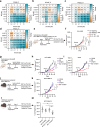De novo pyrimidine biosynthesis inhibition synergizes with BCL-XL targeting in pancreatic cancer
- PMID: 40738904
- PMCID: PMC12311037
- DOI: 10.1038/s41467-025-61242-x
De novo pyrimidine biosynthesis inhibition synergizes with BCL-XL targeting in pancreatic cancer
Abstract
Oncogenic KRAS induces metabolic rewiring in pancreatic ductal adenocarcinoma (PDAC) characterized, in part, by dependency on de novo pyrimidine biosynthesis. Pharmacologic inhibition of dihydroorotate dehydrogenase (DHODH), an enzyme in the de novo pyrimidine synthesis pathway, delays pancreatic tumor growth; however, limited monotherapy efficacy suggests that compensatory pathways may drive resistance. Here, we use an integrated metabolomic, proteomic and in vitro and in vivo DHODH inhibitor-anchored genetic screening approach to identify compensatory pathways to DHODH inhibition (DHODHi) and targets for combination therapy strategies. We demonstrate that DHODHi alters the apoptotic regulatory proteome thereby enhancing sensitivity to inhibitors of the anti-apoptotic BCL2L1 (BCL-XL) protein. Co-targeting DHODH and BCL-XL synergistically induces apoptosis in PDAC cells and patient-derived organoids. The combination of DHODH inhibition with Brequinar and BCL-XL degradation by DT2216, a proteolysis targeting chimera (PROTAC), significantly inhibits PDAC tumor growth. These data define mechanisms of adaptation to DHODHi and support combination therapy targeting BCL-XL in PDAC.
© 2025. The Author(s).
Conflict of interest statement
Competing interests: J.D.M. reports research support to his institution from Novartis and Casma Therapeutics and has consulted for Third Rock Ventures and Skyhawk Therapeutics, all unrelated to the submitted work. A.J.A. has consulted for Anji Pharmaceuticals, Affini-T Therapeutics, Arrakis Therapeutics, AstraZeneca, Boehringer Ingelheim, Kestrel Therapeutics, Merck & Co., Inc., Mirati Therapeutics Inc., Nimbus Therapeutics, Oncorus, Inc., Plexium, Quanta Therapeutics, Revolution Medicines, Reactive Biosciences, Riva Therapeutics, Servier Pharmaceuticals, Syros Pharmaceuticals, T-knife Therapeutics, Third Rock Ventures, and Ventus Therapeutics; holds equity in Riva Therapeutics and Kestrel Therapeutics; and has research funding from Amgen, Boehringer Ingelheim, Bristol Myers Squibb, Deerfield, Inc., Eli Lilly, Mirati Therapeutics Inc., Novartis, Novo Ventures, Revolution Medicines, and Syros Pharmaceuticals, all unrelated to the submitted work. S.K.D. has received research funding from Novartis, Bristol Myers Squibb, Casma Therapeutics and Takeda, has equity in Axxis Bio, and is a co-founder and SAB member for Kojin Therapeutics, all unrelated to the submitted work. All authors declare no competing interests.
Figures






References
-
- Hanahan, D. Hallmarks of cancer: new dimensions. Cancer Discov.12, 31–46 (2022). - PubMed
MeSH terms
Substances
LinkOut - more resources
Full Text Sources
Medical
Research Materials
Miscellaneous

